Read the passage given below and answer the question:
Industrially widely applied esterification reactions are commonly catalysed using mineral liquid acids, such as sulphuric acid and p-toluenesulphonic acid. The catalytic activity of homogeneous catalysts is high. They suffer, however, from several drawbacks, such as their corrosive nature, the existence of side reactions, and the fact that the catalyst cannot be easily separated from the reaction mixture. The use of solid acid catalysts offers an alternative and has received a lot of attention in the past years. Solid acid catalysts are not corrosive and, coated onto a support, they can be easily reused. Examples of solid acid catalysts used in esterification reactions include ion-exchange resins, zeolites and superacids like sulphated zirconia and niobium acid. Ion-exchange resins are the most common heterogeneous catalysts used and have proven to be effective in liquid phase esterification and etherification reactions. Because of their selective adsorption of reactants and swelling nature, these resins not only catalyse the esterification reaction but also affect the equilibrium conversion. Shortcomings include insufficient thermal resistance, which limits the reaction temperature to 120∘C, preventing widespread use in industry. Zeolites, like Y, X, BEA, ZSM-5 and MCM 41 offer an interesting alternative and have proven to be efficient catalysts for esterification reactions. Zeolites have found wide application in oil refining, petrochemistry and in the production of fine chemicals. Their success is based on the possibility to prepare zeolites with strong Brønsted acidity that can be controlled within a certain range, combined with a good resistance to high reaction temperatures.
In this study, the activity of various commercial available solid acid catalysts is assessed with respect to the esterification of acetic acid with butanol. The ion-exchange resins Amberlyst 15 and Smopex-101, the acid zeolites H-ZSM-5, H-MOR, H-BETA and H-USY, and the solid superacids sulphated zirconia and niobium acid are selected. Comparative esterification experiments have been carried out using the homogeneous catalysts sulphuric acid, p toluenesulphuric acid and a heteropolyacid (HPA). The weight-based activity of the heterogeneous catalysts tested is maximum for Smopex 101. The following table gives the activity of different catalysts in the esterification reaction between acetic acid and butanol at 75∘C.
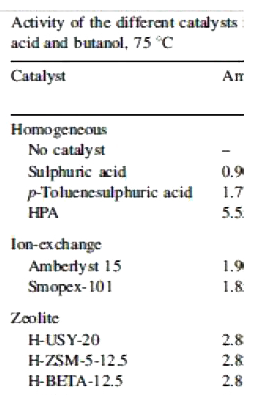
Here: kobs : observed reaction rate constant (m3mol−1s−1) kc catalysed reaction rate constant (m3mol−1g−1cats−1) Please note: k c = k obs/ amount (in g)
(source: PETERS, T., BENES, N., HOLMEN, A., & KEURENTJES, J. (2006). Comparison of commercial solid acid catalysts for the esterification of acetic acid with butanol. Applied Catalysis A: General, 297(2), 182-188. doi:10.1016/j.apcata.2005.09.00)
The weight-based activity of the heterogeneous catalysts tested decreases in the following order:
Smopex-101 > Amberlyst 15 > sulphated ZrO_2 > H-USY-20 > H-BETA-12.5 > HMOR-45 >Nb2O5>H−ZSM−5−12
Smopex-101 > Amberlyst 15> sulphated ZrO2> H-USY-20> H-BETA-12.5> H MOR-45 > H-ZSM-5-12> Nb2O5
Smopex-101 > Amberlyst 15 > sulphated ZrO2 > H-USY-20 > H-BETA-12.5 > Nb2O5> H-MOR-45 > H-ZSM-5-12
Smopex-101 > sulphated ZrO2 > Amberlyst 15 > H-USY-20 > H-BETA-12.5 > H MOR-45 > H-ZSM-5-12> Nb2O5
The correct Answer is:A
Step by step video & image solution for Read the passage given below and answer the question: Industrially widely applied esterification reactions are commonly catalysed using mineral liquid acids, such as sulphuric acid and p-toluenesulphonic acid. The catalytic activity of homogeneous catalysts is high. They suffer, however, from several drawbacks, such as their corrosive nature, the existence of side reactions, and the fact that the catalyst cannot be easily separated from the reaction mixture. The use of solid acid catalysts offers an alternative and has received a lot of attention in the past years. Solid acid catalysts are not corrosive and, coated onto a support, they can be easily reused. Examples of solid acid catalysts used in esterification reactions include ion-exchange resins, zeolites and superacids like sulphated zirconia and niobium acid. Ion-exchange resins are the most common heterogeneous catalysts used and have proven to be effective in liquid phase esterification and etherification reactions. Because of their selective adsorption of reactants and swelling nature, these resins not only catalyse the esterification reaction but also affect the equilibrium conversion. Shortcomings include insufficient thermal resistance, which limits the reaction temperature to 120^(@)C, preventing widespread use in industry. Zeolites, like Y, X, BEA, ZSM-5 and MCM 41 offer an interesting alternative and have proven to be efficient catalysts for esterification reactions. Zeolites have found wide application in oil refining, petrochemistry and in the production of fine chemicals. Their success is based on the possibility to prepare zeolites with strong Brønsted acidity that can be controlled within a certain range, combined with a good resistance to high reaction temperatures. In this study, the activity of various commercial available solid acid catalysts is assessed with respect to the esterification of acetic acid with butanol. The ion-exchange resins Amberlyst 15 and Smopex-101, the acid zeolites H-ZSM-5, H-MOR, H-BETA and H-USY, and the solid superacids sulphated zirconia and niobium acid are selected. Comparative esterification experiments have been carried out using the homogeneous catalysts sulphuric acid, p toluenesulphuric acid and a heteropolyacid (HPA). The weight-based activity of the heterogeneous catalysts tested is maximum for Smopex 101. The following table gives the activity of different catalysts in the esterification reaction between acetic acid and butanol at 75^(@)C. Here: k_(obs) : observed reaction rate constant (m^(3) mol^(-1)s^(-1)) kc catalysed reaction rate constant (m^(3)mol^(-1) g_(cat)^(-1)s^(-1)) Please note: k c = k obs/ amount (in g) (source: PETERS, T., BENES, N., HOLMEN, A., & KEURENTJES, J. (2006). Comparison of commercial solid acid catalysts for the esterification of acetic acid with butanol. Applied Catalysis A: General, 297(2), 182-188. doi:10.1016/j.apcata.2005.09.00) The weight-based activity of the heterogeneous catalysts tested decreases in the following order: by Chemistry experts to help you in doubts & scoring excellent marks in Class 12 exams.
Topper's Solved these Questions
Similar Questions
Read the passage given below and answer the question:
Industrially widely applied esterification reactions are commonly catalysed using mineral liquid acids, such as sulphuric acid and p-toluenesulphonic acid. The catalytic activity of homogeneous catalysts is high. They suffer, however, from several drawbacks, such as their corrosive nature, the existence of side reactions, and the fact that the catalyst cannot be easily separated from the reaction mixture. The use of solid acid catalysts offers an alternative and has received a lot of attention in the past years. Solid acid catalysts are not corrosive and, coated onto a support, they can be easily reused. Examples of solid acid catalysts used in esterification reactions include ion-exchange resins, zeolites and superacids like sulphated zirconia and niobium acid. Ion-exchange resins are the most common heterogeneous catalysts used and have proven to be effective in liquid phase esterification and etherification reactions. Because of their selective adsorption of reactants and swelling nature, these resins not only catalyse the esterification reaction but also affect the equilibrium conversion. Shortcomings include insufficient thermal resistance, which limits the reaction temperature to 120∘C, preventing widespread use in industry. Zeolites, like Y, X, BEA, ZSM-5 and MCM 41 offer an interesting alternative and have proven to be efficient catalysts for esterification reactions. Zeolites have found wide application in oil refining, petrochemistry and in the production of fine chemicals. Their success is based on the possibility to prepare zeolites with strong Brønsted acidity that can be controlled within a certain range, combined with a good resistance to high reaction temperatures.
In this study, the activity of various commercial available solid acid catalysts is assessed with respect to the esterification of acetic acid with butanol. The ion-exchange resins Amberlyst 15 and Smopex-101, the acid zeolites H-ZSM-5, H-MOR, H-BETA and H-USY, and the solid superacids sulphated zirconia and niobium acid are selected. Comparative esterification experiments have been carried out using the homogeneous catalysts sulphuric acid, p toluenesulphuric acid and a heteropolyacid (HPA). The weight-based activity of the heterogeneous catalysts tested is maximum for Smopex 101. The following table gives the activity of different catalysts in the esterification reaction between acetic acid and butanol at 75∘C.
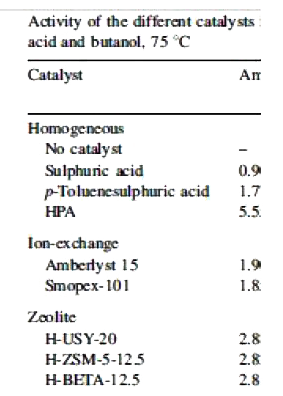
Here: kobs : observed reaction rate constant (m3mol−1s−1) kc catalysed reaction rate constant (m3mol−1g−1cats−1) Please note: k c = k obs/ amount (in g)
(source: PETERS, T., BENES, N., HOLMEN, A., & KEURENTJES, J. (2006). Comparison of commercial solid acid catalysts for the esterification of acetic acid with butanol. Applied Catalysis A: General, 297(2), 182-188. doi:10.1016/j.apcata.2005.09.00)
Catalysts used in oil refining industry are:View SolutionRead the passage given below and answer the question:
Industrially widely applied esterification reactions are commonly catalysed using mineral liquid acids, such as sulphuric acid and p-toluenesulphonic acid. The catalytic activity of homogeneous catalysts is high. They suffer, however, from several drawbacks, such as their corrosive nature, the existence of side reactions, and the fact that the catalyst cannot be easily separated from the reaction mixture. The use of solid acid catalysts offers an alternative and has received a lot of attention in the past years. Solid acid catalysts are not corrosive and, coated onto a support, they can be easily reused. Examples of solid acid catalysts used in esterification reactions include ion-exchange resins, zeolites and superacids like sulphated zirconia and niobium acid. Ion-exchange resins are the most common heterogeneous catalysts used and have proven to be effective in liquid phase esterification and etherification reactions. Because of their selective adsorption of reactants and swelling nature, these resins not only catalyse the esterification reaction but also affect the equilibrium conversion. Shortcomings include insufficient thermal resistance, which limits the reaction temperature to 120∘C, preventing widespread use in industry. Zeolites, like Y, X, BEA, ZSM-5 and MCM 41 offer an interesting alternative and have proven to be efficient catalysts for esterification reactions. Zeolites have found wide application in oil refining, petrochemistry and in the production of fine chemicals. Their success is based on the possibility to prepare zeolites with strong Brønsted acidity that can be controlled within a certain range, combined with a good resistance to high reaction temperatures.
In this study, the activity of various commercial available solid acid catalysts is assessed with respect to the esterification of acetic acid with butanol. The ion-exchange resins Amberlyst 15 and Smopex-101, the acid zeolites H-ZSM-5, H-MOR, H-BETA and H-USY, and the solid superacids sulphated zirconia and niobium acid are selected. Comparative esterification experiments have been carried out using the homogeneous catalysts sulphuric acid, p toluenesulphuric acid and a heteropolyacid (HPA). The weight-based activity of the heterogeneous catalysts tested is maximum for Smopex 101. The following table gives the activity of different catalysts in the esterification reaction between acetic acid and butanol at 75∘C.
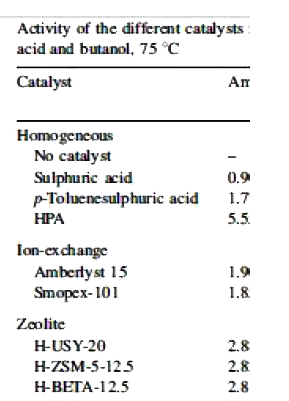
Here: kobs : observed reaction rate constant (m3mol−1s−1) kc catalysed reaction rate constant (m3mol−1g−1cats−1) Please note: k c = k obs/ amount (in g)
(source: PETERS, T., BENES, N., HOLMEN, A., & KEURENTJES, J. (2006). Comparison of commercial solid acid catalysts for the esterification of acetic acid with butanol. Applied Catalysis A: General, 297(2), 182-188. doi:10.1016/j.apcata.2005.09.00)
The catalytic activity of homogeneous catalysts is high. The weight based activity of HPA is less than which of the following heterogenous catalysts?View Solution
Knowledge Check
- Question 1 - Select One
Read the passage given below and answer the question:
Industrially widely applied esterification reactions are commonly catalysed using mineral liquid acids, such as sulphuric acid and p-toluenesulphonic acid. The catalytic activity of homogeneous catalysts is high. They suffer, however, from several drawbacks, such as their corrosive nature, the existence of side reactions, and the fact that the catalyst cannot be easily separated from the reaction mixture. The use of solid acid catalysts offers an alternative and has received a lot of attention in the past years. Solid acid catalysts are not corrosive and, coated onto a support, they can be easily reused. Examples of solid acid catalysts used in esterification reactions include ion-exchange resins, zeolites and superacids like sulphated zirconia and niobium acid. Ion-exchange resins are the most common heterogeneous catalysts used and have proven to be effective in liquid phase esterification and etherification reactions. Because of their selective adsorption of reactants and swelling nature, these resins not only catalyse the esterification reaction but also affect the equilibrium conversion. Shortcomings include insufficient thermal resistance, which limits the reaction temperature to 120∘C, preventing widespread use in industry. Zeolites, like Y, X, BEA, ZSM-5 and MCM 41 offer an interesting alternative and have proven to be efficient catalysts for esterification reactions. Zeolites have found wide application in oil refining, petrochemistry and in the production of fine chemicals. Their success is based on the possibility to prepare zeolites with strong Brønsted acidity that can be controlled within a certain range, combined with a good resistance to high reaction temperatures.
In this study, the activity of various commercial available solid acid catalysts is assessed with respect to the esterification of acetic acid with butanol. The ion-exchange resins Amberlyst 15 and Smopex-101, the acid zeolites H-ZSM-5, H-MOR, H-BETA and H-USY, and the solid superacids sulphated zirconia and niobium acid are selected. Comparative esterification experiments have been carried out using the homogeneous catalysts sulphuric acid, p toluenesulphuric acid and a heteropolyacid (HPA). The weight-based activity of the heterogeneous catalysts tested is maximum for Smopex 101. The following table gives the activity of different catalysts in the esterification reaction between acetic acid and butanol at 75∘C.
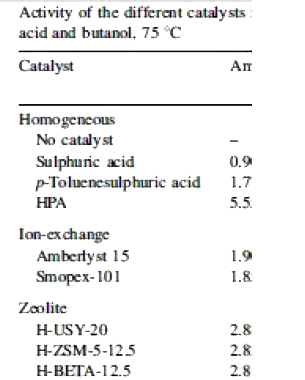
Here: kobs : observed reaction rate constant (m3mol−1s−1) kc catalysed reaction rate constant (m3mol−1g−1cats−1) Please note: k c = k obs/ amount (in g)
(source: PETERS, T., BENES, N., HOLMEN, A., & KEURENTJES, J. (2006). Comparison of commercial solid acid catalysts for the esterification of acetic acid with butanol. Applied Catalysis A: General, 297(2), 182-188. doi:10.1016/j.apcata.2005.09.00)
Which of the following are heterogeneous catalysts for esterifctaion reaction:Asulphuric acid and p-toluenesulphonic acidBsulphuric acid and niobium acidCp-toluenesulphonic acid and niobium acidDniobium acid and sulphated zirconia - Question 2 - Select One
Given three acids
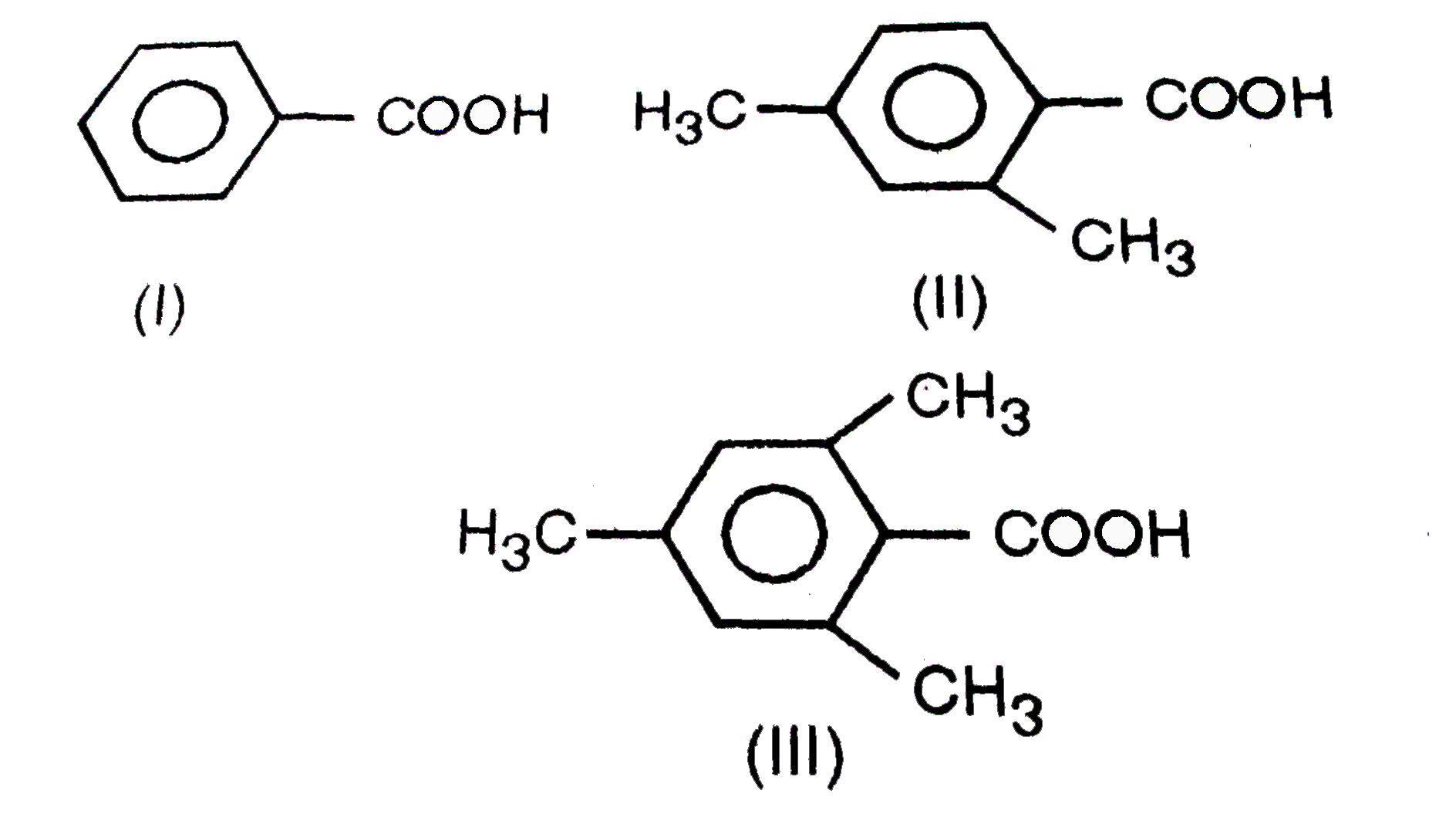
The order of ease of acid catalysed esterification isAI>III>IIBI>II>IIICIII>I>IIDII>III>I - Question 3 - Select One
Due to use of catalyst in reaction
Aactivation energy is increasedBactivation energy is decreacedCactivation energy remain unchangedDheat of reaction changes
Read the passage given below and answer the question:
Industrially widely applied esterification reactions are commonly catalysed using mineral liquid acids, such as sulphuric acid and p-toluenesulphonic acid. The catalytic activity of homogeneous catalysts is high. They suffer, however, from several drawbacks, such as their corrosive nature, the existence of side reactions, and the fact that the catalyst cannot be easily separated from the reaction mixture. The use of solid acid catalysts offers an alternative and has received a lot of attention in the past years. Solid acid catalysts are not corrosive and, coated onto a support, they can be easily reused. Examples of solid acid catalysts used in esterification reactions include ion-exchange resins, zeolites and superacids like sulphated zirconia and niobium acid. Ion-exchange resins are the most common heterogeneous catalysts used and have proven to be effective in liquid phase esterification and etherification reactions. Because of their selective adsorption of reactants and swelling nature, these resins not only catalyse the esterification reaction but also affect the equilibrium conversion. Shortcomings include insufficient thermal resistance, which limits the reaction temperature to 120∘C, preventing widespread use in industry. Zeolites, like Y, X, BEA, ZSM-5 and MCM 41 offer an interesting alternative and have proven to be efficient catalysts for esterification reactions. Zeolites have found wide application in oil refining, petrochemistry and in the production of fine chemicals. Their success is based on the possibility to prepare zeolites with strong Brønsted acidity that can be controlled within a certain range, combined with a good resistance to high reaction temperatures.
In this study, the activity of various commercial available solid acid catalysts is assessed with respect to the esterification of acetic acid with butanol. The ion-exchange resins Amberlyst 15 and Smopex-101, the acid zeolites H-ZSM-5, H-MOR, H-BETA and H-USY, and the solid superacids sulphated zirconia and niobium acid are selected. Comparative esterification experiments have been carried out using the homogeneous catalysts sulphuric acid, p toluenesulphuric acid and a heteropolyacid (HPA). The weight-based activity of the heterogeneous catalysts tested is maximum for Smopex 101. The following table gives the activity of different catalysts in the esterification reaction between acetic acid and butanol at 75∘C.

Here: kobs : observed reaction rate constant (m3mol−1s−1) kc catalysed reaction rate constant (m3mol−1g−1cats−1) Please note: k c = k obs/ amount (in g)
(source: PETERS, T., BENES, N., HOLMEN, A., & KEURENTJES, J. (2006). Comparison of commercial solid acid catalysts for the esterification of acetic acid with butanol. Applied Catalysis A: General, 297(2), 182-188. doi:10.1016/j.apcata.2005.09.00)
Unit for observed rate constant for esterification reaction is m³mol−1s−1, so the reaction is:View SolutionWhat kind of reactions are not catalysed by the catalyst?
View SolutionA catalyst is used in a reaction to
View SolutionA catalyst is used in a reaction to
View SolutionA catalyst is used in a reaction to
View Solution

